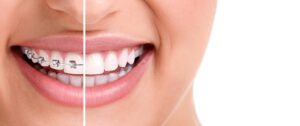Dental Braces Explained: A Complete Guide for First-Time Wearers
Dental braces are a popular solution for correcting misaligned teeth and improving overall oral health. They are designed to gradually shift teeth into their proper positions, leading to better function, appearance, and long-term dental stability. For many people, braces are the first step towards a straighter, healthier smile.
The process can seem intimidating at first, but modern braces are more comfortable and effective than ever before. They are used to treat a variety of dental issues, such as crowded teeth, gaps between teeth, overbites, underbites, and crossbites. While the idea of wearing braces might seem daunting, the long-term benefits far outweigh the temporary inconveniences.
Types of Dental Braces
There are several types of dental braces available today, each with its own set of features and advantages. Understanding the different types can help you choose the right one based on your needs and preferences.
Traditional Metal Braces

These are the most common type of braces and are often recommended for people with complex dental issues. Traditional metal braces consist of metal brackets that are attached to the teeth and connected with a wire. Small rubber bands are used to keep the wire in place and help move the teeth.
- Pros: They are highly effective at addressing a wide range of dental problems. The treatment is typically quicker than other options, and modern versions are smaller and more comfortable than in the past.
- Cons: They are more noticeable than other types of braces, which can be a concern for some people, particularly adults.
Ceramic Braces
Ceramic braces work in much the same way as traditional metal braces, but the brackets are made from clear or tooth-colored material, making them less visible. They are a popular choice for those who want a more discreet option but still need the effectiveness of traditional braces.
- Pros: These braces are less noticeable, making them a good option for adults or teens who are self-conscious about their appearance.
- Cons: They tend to be slightly larger than metal braces and may require more careful maintenance to avoid staining.
Lingual Braces
Lingual braces are similar to traditional metal braces but are placed on the back of the teeth, making them completely hidden from view. They are custom-made to fit the shape of your teeth and are a great option for people who want the benefits of braces without the visibility.
- Pros: They are completely invisible to others, offering a discreet treatment option.
- Cons: Lingual braces can be more uncomfortable at first, and they may require more frequent adjustments. They are also more difficult to clean and maintain.
Clear Aligners (e.g., Invisalign)
Clear aligners, such as Invisalign, are a more recent option for teeth straightening. These are removable plastic trays that gradually shift teeth into position. Since they are clear, they are barely noticeable when worn, making them an attractive option for people who want a discreet treatment.
- Pros: Clear aligners are removable, which makes eating and cleaning teeth much easier. They are also more comfortable than traditional braces and allow for greater flexibility.
- Cons: Clear aligners may not be suitable for severe dental issues. They also require consistent wear to be effective, which means they can be less effective for people who struggle with consistency.
The Process of Getting Dental Braces
Getting dental braces is a step-by-step process that involves a few important stages. From your first consultation to the final adjustment, understanding the process can help ease any concerns and prepare you for what to expect.
Initial Consultation
The first step in getting braces is scheduling a consultation with an orthodontist. During this visit, the orthodontist will examine your teeth, take X-rays, and discuss your dental goals. This is a great time to ask any questions you might have about the braces process, the types of braces available, and how long treatment might take.
The orthodontist will also discuss your medical history to ensure that you are a good candidate for braces. They may use digital scans or impressions of your teeth to create a treatment plan tailored to your needs.
Fitting the Braces
Once you’ve decided on the type of braces, the next step is getting them fitted. The process generally takes about one to two hours. Your orthodontist will begin by cleaning your teeth to remove any plaque or debris. Then, the brackets will be attached to the front of your teeth using a special adhesive.
After the brackets are in place, the archwire is threaded through them. The wire is held in place with small rubber bands, which can come in various colors for a more personalized look. For those choosing ceramic or lingual braces, the procedure may be slightly different, but the basic steps are the same.
Although getting braces put on doesn’t hurt, you might feel some pressure or discomfort afterward. Your orthodontist will ensure that everything is properly adjusted before you leave.
Adjustments and Follow-ups
After the braces are fitted, you’ll need to return to the orthodontist for regular check-ups and adjustments. These appointments are typically scheduled every 4 to 6 weeks. At these visits, the orthodontist will tighten or adjust the wires to continue moving your teeth into the desired position.
While these adjustments may cause some mild discomfort, they are necessary to ensure that the treatment progresses as planned. Over time, as your teeth shift and align, the appointments may become less frequent. However, you’ll need to stick to the recommended schedule to achieve the best results.
How Dental Braces Work to Straighten Teeth
Dental braces are designed to gradually move your teeth into the correct position. They work through a combination of pressure and time, using components like brackets, wires, and rubber bands to shift teeth into alignment. Understanding how braces work can help you appreciate the process and the time it takes to achieve a perfect smile.
Brackets and Wires

The main components of dental braces are the brackets and the archwire. The brackets are small squares that are attached to each tooth using a strong adhesive. They act as anchors for the braces, helping to guide the teeth into their new positions. The archwire is a thin metal wire that connects the brackets, and it provides the force needed to move your teeth.
At each adjustment, the archwire is tightened to increase the pressure on your teeth, encouraging them to shift slowly into the correct alignment. Over time, this pressure will reshape the bone around your teeth, which is how they eventually settle into place.
Elastic Bands and Other Accessories
In some cases, elastic bands or other accessories are used in conjunction with braces to achieve specific results. These components help correct issues such as overbites, underbites, or crossbites by applying extra pressure to certain teeth or areas of the mouth.
- Elastic Bands: These small rubber bands are attached to hooks on the brackets and can be used to create a more precise movement of the teeth. The orthodontist will direct the placement of these bands based on your individual needs.
- Spacers: Spacers are small rubber or metal rings that are placed between your teeth to create space for the bands that help the braces function effectively.
- Headgear: In more complex cases, your orthodontist might recommend headgear, which is worn outside the mouth and attaches to the braces to help correct jaw and bite issues.
These accessories are often used in specific situations to help move teeth or jaws more efficiently. Your orthodontist will explain how and when to use them to ensure the treatment progresses smoothly.
Common Concerns and Myths About Dental Braces
Many people have concerns when it comes to getting dental braces, especially if it’s their first time. Understanding common myths and addressing concerns can help ease anxiety and prepare you for a smooth experience. Let’s address some of the most frequently asked questions and misconceptions about braces.
Pain and Discomfort
It’s natural to be concerned about the potential pain or discomfort associated with braces. While it’s true that you may experience some discomfort after the braces are first placed or following adjustments, it typically doesn’t last long.
- Initial Discomfort: After getting braces, you may feel some soreness in your teeth and gums as they adjust to the pressure. This discomfort usually subsides within a few days.
- Adjustments: Each time the braces are tightened, there may be mild soreness. Over-the-counter pain relievers, like ibuprofen, can help manage this discomfort.
- Mouth Irritation: Brackets and wires can cause irritation to the inside of your lips and cheeks, especially during the first few weeks. Using orthodontic wax can help cover sharp edges and reduce friction.
With the right care, any discomfort is temporary and manageable. The end result—a healthier, straighter smile—is well worth the minor inconveniences along the way.
Eating with Braces
One of the most common concerns is about food restrictions while wearing braces. Certain foods can damage the brackets or get stuck in the wires, so it’s important to avoid certain types of food during treatment.
Foods to Avoid:
- Hard or sticky foods (e.g., candy, gum, popcorn) can break or dislodge the brackets and wires.
- Crunchy foods (e.g., apples, carrots) should be cut into smaller pieces to avoid putting too much pressure on the braces.
- Sugary snacks and drinks can increase the risk of cavities, as food particles can get stuck in the braces and lead to plaque buildup.
Foods That Are Safe:
- Soft foods like yogurt, mashed potatoes, and pasta are easier to eat and won’t harm the braces.
- Cutting hard foods into smaller, bite-sized pieces will also help protect your braces.
- It’s essential to maintain a balanced diet and practice good oral hygiene to keep both your braces and your teeth in good condition.
Cleaning and Maintenance
Keeping your braces clean is crucial for both oral health and the effectiveness of the treatment. Proper hygiene can prevent cavities, gum disease, and staining around the brackets.
Brushing and Flossing:
- You should brush your teeth after every meal to remove food particles and plaque. Using a soft-bristled toothbrush is recommended to avoid damaging the braces.
- Flossing is more challenging with braces, but there are special floss threads or floss picks designed for use with braces. Regular flossing helps prevent gum disease and tooth decay.
Using Mouthwash:
- Antibacterial mouthwash can help reduce the risk of gum disease and keep your breath fresh. Rinsing after meals can remove small particles stuck between teeth.
Regular Check-ups:
- Regular orthodontic visits are key to keeping your treatment on track. Your orthodontist will ensure the braces are in good condition and make any necessary adjustments.
Take the Next Step Toward Your Perfect Smile
Choosing an orthodontist is an important decision. At Princeton Orthodontics, you’ll receive the expertise of Dr. Jonathan Nicozisis, a nationally recognized leader in Invisalign and orthodontic care. With years of experience and a passion for advanced techniques, Dr. Nicozisis brings the latest innovations to his practice, ensuring you get the best results possible.
If you’re uncertain about which treatment is right for you or your child, trust Dr. Nicozisis to offer expert advice tailored to your needs. Schedule your consultation today and discover how Invisalign and cutting-edge technology can make a difference in your smile. Don’t let misconceptions hold you back—see what a true orthodontic specialist can do!





